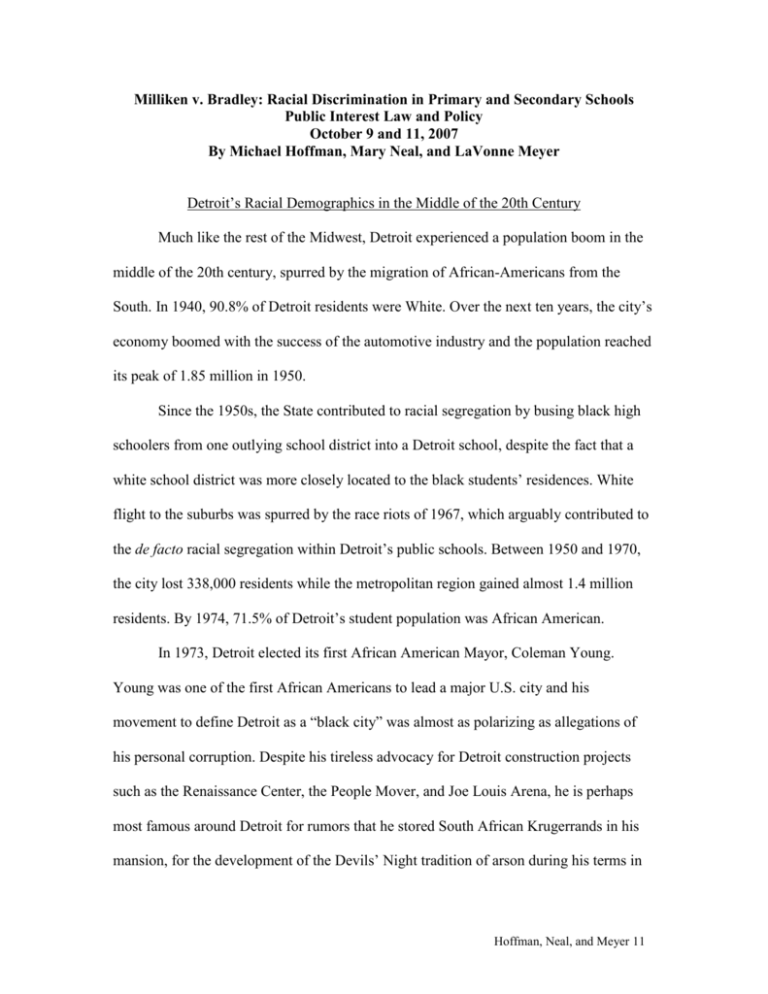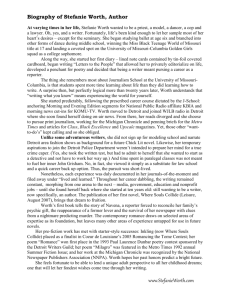MIlliken Paper-Hoffman Meyer and Neal - Chicago
advertisement

Milliken v. Bradley: Racial Discrimination in Primary and Secondary Schools Public Interest Law and Policy October 9 and 11, 2007 By Michael Hoffman, Mary Neal, and LaVonne Meyer Detroit’s Racial Demographics in the Middle of the 20th Century Much like the rest of the Midwest, Detroit experienced a population boom in the middle of the 20th century, spurred by the migration of African-Americans from the South. In 1940, 90.8% of Detroit residents were White. Over the next ten years, the city’s economy boomed with the success of the automotive industry and the population reached its peak of 1.85 million in 1950. Since the 1950s, the State contributed to racial segregation by busing black high schoolers from one outlying school district into a Detroit school, despite the fact that a white school district was more closely located to the black students’ residences. White flight to the suburbs was spurred by the race riots of 1967, which arguably contributed to the de facto racial segregation within Detroit’s public schools. Between 1950 and 1970, the city lost 338,000 residents while the metropolitan region gained almost 1.4 million residents. By 1974, 71.5% of Detroit’s student population was African American. In 1973, Detroit elected its first African American Mayor, Coleman Young. Young was one of the first African Americans to lead a major U.S. city and his movement to define Detroit as a “black city” was almost as polarizing as allegations of his personal corruption. Despite his tireless advocacy for Detroit construction projects such as the Renaissance Center, the People Mover, and Joe Louis Arena, he is perhaps most famous around Detroit for rumors that he stored South African Krugerrands in his mansion, for the development of the Devils’ Night tradition of arson during his terms in Hoffman, Neal, and Meyer 11 office, and for his famous quote: “It’s time to leave Detroit; hit Eight Mile Road!” While the statement was part of a longer plea for criminals of all races to leave the city, whites who were already moving out to the suburbs rarely heard more than the terse excerpt and assumed the mayor was speaking to them. The separation of white and black populations in Metro Detroit was dramatic. The National Academy of Sciences Advisory Committee to the Department of Housing and Urban Development described Detroit in 1972 as a “web of discrimination” that maintained racially separate housing markets and ensured segregation. Journal of Housing Research, Vol. 4.1 1993 p.2. Without transportation between the black city and white suburbs, the existence of these separate neighborhoods acted to bar integration of locally-tied public services such as schools. The Detroit Public Schools and the Origin of Milliken v. Bradley In 1970, the Detroit Board of Education voluntarily began implementation of what came to be known as the “April 7, 1970 Plan” in an effort to desegregate the city’s high schools. Milliken v. Bradley, 418 U.S. 717, 727 (1974). It was slated to become effective during the fall semester of 1970. Id. However, the Michigan state legislature thwarted the Board’s attempts to racially integrate the schools through overt action and inaction. Id. One clear example of the legislature’s efforts was Act 48 of the Public Acts of 1970, which delayed the implementation of the April 7 Plan and perpetuated the growing segregation of the Detroit school system. Id. In particular, § 12 of the Act prescribed “free choice” and “neighborhood schools” in each of Detroit’s eight regions. Id. Furthermore, the legislature delayed the authorization of and funding for pupil Hoffman, Neal, and Meyer 21 transportation within Detroit, while at the same time providing neighboring (and primarily white) suburban districts a full range of state-supported transportation. Id. at 726-727. Finally, the legislature amended the State Transportation Aid Act to cover intracity transportation, but expressly prohibited the allocation of funds for the crossbusing of students within a school district to achieve racial balance. Id. In addition to the legislature’s actions, the Detroit Board of Education developed and maintained what were known as “optional attendance zones,” which allowed white students to avoid attending schools in neighborhoods undergoing racial integration. Id. at 725. These actions prompted the lawsuit Milliken v. Bradley, which challenged the constitutionality of Michigan’s statutes. The class action suit, which was named for two African-American children, Ronald Bradley and Richard Bradley, was brought by their mother, Verda Bradley. Nathanial R. Jones brought the suit on behalf of the plaintiffs. Jones was the general counsel for the NAACP; Thomas Atkins replaced him as lead counsel during later phases of litigation. With him on the case were Paul R. Dimond, Louis R. Lucas, Robert A. Murphy, William E. Caldwell, and Richard S. Kohn. The plaintiffs alleged that the policies, actions, and inaction of Detroit and Michigan officials contributed to de jure racial segregation within the Detroit school district. The suit named numerous defendants, including Michigan governor William G. Milliken, Michigan Attorney General Frank J. Kelley, the State Superintendent of Public Instruction, the State Treasurer, the Michigan Board of Education, the Detroit Board of Education and its members, and Detroit’s current and former school superintendents. School Desegregation Caselaw Prior to Milliken I Hoffman, Neal, and Meyer 31 The Supreme Court declared that segregated schools violated the Fourteenth Amendment of the Constitution in Brown v. Board of Education, but put off discussion of appropriate remedies until the next year. 347 U.S. 483 (1954). Then, in Brown II the Court held that “In fashioning and effectuating the decrees, the courts will be guided by equitable principles. Traditionally, equity has been characterized by a practical flexibility in shaping its remedies and by a facility for adjusting and reconciling public and private needs.” Brown v. Board of Education II, 349 U.S. 294, 299-300 (1955). Such remedies were best ordered and overseen by the District Courts “[b]ecause of their proximity to local conditions and the possible need for further hearings.” Id. at 299. The Court envisioned broad remedies touching on aspects of a school system: physical facilities, transportation of students, assignment of personnel, and even the redrawing of attendance zones and district boundaries. Id. at 300-301. The Court also famously declared that remedies to segregation should be implemented “with all deliberate speed.” Id at 301. Efficiency and Practicality of Remedies Throughout the 1960s and into the early 1970s, the Court grew impatient with parties seeking to stall or obstruct implementation of court-ordered desegregation plans. In Green v. County School Board the Court expressed frustration at a Virginia school board's feeble efforts to comply with Brown by eliminating de jure segregation without taking any effective steps to alter the composition of either the student body or the faculty and staff of county schools. 391 U.S. 430, 439 (U.S. 1968). Thirteen years after Brown, the Court declared that the time for deliberate speed was over, and “[t]he burden on a school board today is to come forward with a plan that promises realistically to work, and promises realistically to work now.” Id. (emphasis in original). Similarly, in U.S. v. Hoffman, Neal, and Meyer 41 Montgomery County Board of Education, the Court reinstated a district court desegregation plan over the modified order of the Court of Appeals holding that “[t]he modifications ordered by the panel of the Court of Appeals... would, we think, take from the order some of its capacity to expedite... the day when a completely unified, unitary, nondiscriminatory school system becomes a reality.” 395 U.S. 225, 235 (1969). Breadth of Remedies Also during this time period, the Court approved very broad equitable remedies by district courts in desegregation cases. The most expansive equitable remedy approved by the Court was likely that in Swann v. Charlotte-Mecklenburg Board of Education in which the Court held that “[o]nce a right and a violation have been shown, the scope of a district court's equitable powers to remedy past wrongs is broad, for breadth and flexibility are inherent in equitable remedies.” 402 U.S. 1, 15 (1971). In this case, the Court approved a remedy including reassignment of faculty, transportation of students between the City of Charlotte and suburban and rural areas of the county, and even “gerrymandering of school districts and attendance zones.” Id. at 8-9. While the remedy approved in Swann would seem to give limitless power to the District Courts in fashioning equitable remedies, the Court did caution that while “[n]o fixed or even substantially fixed guidelines can be established as to how far a court can go,” still “it must be recognized that there are limits.” Id. at 28. The Court further stated that “[a]s with any equity case, the nature of the violation determines the scope of the remedy.” The Supreme Court's approval of a broad, county-wide remedy in Swann, coupled with its hesitance to set any clear limits on the scope of district courts' powers in such cases, challenged prospective plaintiffs and district court judges to “push the envelope” Hoffman, Neal, and Meyer 51 when crafting remedies for segregation. In Milliken, the district court's inter-district remedy tested the limits of Swann. Objectives of Remedies While the Court was very vague about the limits of equitable remedies, it did give some guidance as to the proper objective of desegregation orders. “The first remedial responsibility of school authorities is to eliminate invidious racial distinctions,” the Court held, echoing language from Green. Id. at 18. While recognizing that accurate knowledge of the area's racial demographics was useful in crafting and monitoring a desegregation plan, the Court held that “[t]he constitutional command to desegregate schools does not mean that every school in every community must always reflect the racial composition of the school system as a whole.” Id. at 24. Supreme Court Holding in Milliken I Constitutional violations addressed by the Supreme Court in Milliken I The Milliken plaintiffs alleged that the defendants’ policies and actions created de jure racial segregation within Detroit’s schools in violation of the Fourteenth Amendment’s Equal Protection Clause. The plaintiffs maintained that these policies and actions denied African-American schoolchildren educational opportunities enjoyed by their white counterparts. Accordingly, they sought the implementation of a plan to eliminate Detroit’s dual school system and promote racial integration. The United States District Court for the Eastern District of Michigan found evidence that de jure segregation existed within the Detroit schools and ordered the parties to submit desegregation plans for both Detroit and the three-county metropolitan Hoffman, Neal, and Meyer 61 area, despite the fact that no suburban school districts were parties to the action and that the plaintiffs had not alleged any unconstitutional violation by these outlying districts. The United States Court of Appeals for the Sixth Circuit affirmed the District Court’s holding that de jure segregation existed in Detroit and agreed that a metropolitanwide remedy, rather than a city-only remedy, was necessary to dismantle the segregation present throughout the city’s schools. However, the Supreme Court disagreed, holding that the evidence on the record warranted only a city-wide remedy. Chief Justice Burger, who authored the Court’s 5-4 majority decision, began his discussion of the Fourteenth Amendment by noting that “[N]o state law is above the Constitution. School district lines and the present laws with respect to local control are not sacrosanct, and if they conflict with the Fourteenth Amendment, federal courts have a duty to prescribe appropriate remedies.” Milliken, 418 U.S. at 744. Burger asserted, however, that the issue presented in Milliken – that is, the validity of a judicial remedy mandating inter-district consolidation to rectify racial segregation that existed in only one school district – was an issue of first impression before the Court. As such, the Court’s prior holdings addressing dual public school systems and various state and local officials’ roles in drawing district lines in order to maintain racial segregation in public schools were therefore not directly applicable to Milliken’s facts. See id. Burger’s opinion further distinguished Milliken from precedent cases by attacking the metropolitan-wide remedy fashioned by the District Court and upheld by the Sixth Circuit. He conceded that although the record contained evidence of de jure segregated conditions in the Detroit schools, an inter-district remedy would be “wholly Hoffman, Neal, and Meyer 71 impermissible [and] based on a standard not hinted at in Brown I and II or any holding of this Court.” Milliken at 745. Justice Stewart’s concurrence noted that the Supreme Court upheld the Sixth Circuit’s finding of an Equal Protection Clause violation, but he maintained that Milliken’s procedural posture did not concern questions of substantive constitutional law. Instead, he asserted that the basic issue the Court needed to address was “the appropriate exercise of federal equity jurisdiction.” Milliken at 753. Because Stewart agreed that no inter-district constitutional violations existed, he wrote that “the mere fact of different racial compositions in contiguous districts does not itself imply or constitute a violation of the Equal Protection Clause in the absence of a showing that such disparity was imposed, fostered, or encouraged by the State or its political subdivisions…” Milliken at 756. According to Justice Douglas’ dissent, the central issue of Milliken was “not whether there should be racial balance [in the public schools] but whether the State’s use of various devices that end up with black schools and white schools brought the Equal Protection Clause into effect … since Michigan by one device or another has over the years created black school districts and white school districts, the task of equity is to provide a unitary system for the affected area where, as here, the State washes its hands of its own creations.” Milliken at 762. Douglas ruefully noted, “Today’s decision … means that there is no violation of the Equal Protection Clause though the schools are segregated by race and though the black schools are not only ‘separate’ but ‘inferior.’ So far as equal protection is concerned, we are now in a dramatic retreat from the 7-to-1 Hoffman, Neal, and Meyer 81 decision in 1896 that blacks could be segregated in public facilities, provided they received equal treatment.” Milliken at 761. Justice White’s dissent reiterated Douglas’ concern that the majority’s holding “would call up haunting memories of the now long overruled and discredited ‘separate but equal doctrine’ of Plessy v. Ferguson” and could eventually lead to the nullification of Brown v. Board of Education. Milliken at 767. He also noted that the holding allowed “the State of Michigan, the entity at which the Fourteenth Amendment is directed, [to] successfully insulate itself from its duty to provide effective desegregation remedies by vesting sufficient power over its public schools in its local school districts.” Milliken at 763. He then expressed concern that the judicial lenience shown to Michigan would be replicated in other states found to have violated the Fourteenth Amendment. Id. Finally, White pointed out that white as well as black students suffered from the effects of segregated education policies when they were not allowed to attend schools and learn together. Id. at 779. Justice Marshall began his dissenting opinion by invoking Brown I’s holding and the role of the Fourteenth Amendment in ensuring equal educational opportunities for all children. He noted the difficulties inherent in desegregating schools, but quoted the nowfamous passage from Cooper v. Aaron: “[H]owever embedded old ways, however ingrained old prejudices, this Court has not been diverted from its appointed task of making a ‘living truth’ of our constitutional idea of equal justice under law.” Milliken at 781-82 (citing Cooper v. Aaron, 358 U.S. 1, 20 (1958)). He asserted that the majority “[took] a giant step backwards” after 20 years of widespread efforts to implement the Brown mandate. Id. at 782. The decision, he wrote, “[guaranteed] that Negro children in Hoffman, Neal, and Meyer 91 Detroit will receive the same separate and inherently unequal education in the future as they have been unconstitutionally afforded in the past” and characterized it as an “emasculation of our constitutional guarantee of equal protection of the laws…” Id. Like his fellow dissenting colleagues, Marshall emphasized that “actions by an agent or officer of the State are encompassed by the Fourteenth Amendment,” that school districts such as Detroit’s were agencies of the State government, and that “[r]acial discrimination by the school district, an agency of the State, is therefore racial discrimination by the State itself.” Milliken at 792-93. Marshall acknowledged the racial inequality inherent in the Detroit school system: “Absent a constitutional violation there would be no basis for judicially ordering assignment of students on a racial basis … But all things are not equal in a system that has been deliberately constructed and maintained to enforce segregation.” Milliken at 814 (quoting Swann v. Charlotte-Mecklenburg Bd. of Ed., 402 U.S. 1, 28 1971)). Marshall concluded his dissent by admitting that desegregation would pose challenges to the school district, but insisted that the Court’s role in upholding the Constitution’s equal protection guarantee superseded the majority’s inclination to bow to public pressure and discontinue its efforts to ensure that States and their agents abided by the mandates of the Fourteenth Amendment. De facto Versus De Jure Segregation Milliken does not discuss the distinction between de facto and de jure segregation at length since the Supreme Court itself conceded that de jure segregation existed in the Detroit school system. However, it is worth noting that the de facto segregation that arguably existed in the decades prior to Milliken was due to factors other than official policies and decisions that can be characterized as discriminatory. Hoffman, Neal, and Meyer 101 De jure segregation, in contrast, is triggered by officials’ policies or decisions that either create or maintain racial segregation, and the allegedly discriminatory actions by local and state officials caused the de jure segregation that prompted the initial lawsuit. Local Control in Michigan Public Education Burger justified the majority’s holding, in part, by noting the importance of autonomy by individual school districts: “No single tradition in public education is more deeply rooted than local control over the operation of schools; local autonomy has long been thought essential both to the maintenance of community concern and support for public schools and to quality of the educational process.” Milliken at 741-42. However, Douglas, White, and Marshall each delivered a scathing attack on this position in their dissents. Douglas noted that Michigan’s educational system is actually a unitary one, maintained and supported by the state legislature and supervised by the State Board of Education. See Milliken at 758. White argued that the Michigan legislature’s attempt to dismantle the Detroit Board of Education’s April 7 Plan in 1971 proved that the state indeed maintained control over local school districts. See Milliken at 768. Marshall expanded upon Douglas’ opinion, citing Michigan case law and statutes in noting that “Michigan, unlike some other States, operates a single statewide system of education … the majority’s emphasis on local governmental control and local autonomy of school districts in Michigan will come as a surprise to those with any familiarity with that State’s system of education.” Milliken at 794. He concluded that the majority’s invocation of deeply rooted traditions of local autonomy “simply flies in the face of reality...” See Milliken at 797. The Scope of the Remedy in School Desegregation Cases: Hoffman, Neal, and Meyer 111 Majority Holding and Criticism by Dissenters The Milliken majority invoked its standard controlling principle in equity cases, applying the general standard stated in Swann to the specifics of the case at hand: [T]he scope of the remedy is determined by the nature and extent of the constitutional violation…Specifically, it must be shown that racially discriminatory acts of the state or local school districts, or of a single school district have been a substantial cause of inter-district segregation… Conversely, without an inter-district violation and inter-district effect, there is no constitutional wrong calling for an inter-district remedy. Milliken at 744-45. Because the record contained no evidence of constitutional violations by the 53 outlying school districts included in the District Court’s metropolitan remedy, the majority held that the lower court went beyond the case’s original theory and exceeded its remedial powers in fashioning such relief. See Milliken at 745. Douglas responded by arguing that “[m]etropolitan treatment of metropolitan problems is commonplace,” citing sewage, water, and energy problems as examples in which Michigan would be well within its federal constitutional bounds to seek a metropolitan remedy. See Milliken at 758. White challenged the majority’s approach as well, opining that “the Court fashions out of whole cloth an arbitrary rule that remedies for constitutional violations occurring in a single Michigan school district must stop at the school district line.” Milliken at 768. He also attacked the majority’s departure from the traditional approach of allowing lower courts to fashion equitable remedies under the presupposition that such courts are more familiar with both the record and the particular factual circumstances of a given case. See Milliken at 769. Constitutional violations addressed by the Supreme Court in Milliken II Hoffman, Neal, and Meyer 121 Following the Supreme Court’s remand in Milliken I to fashion an appropriate remedy to desegregate the Detroit school system, the District Court entered an order requiring pupil assignments and the implementation of various compensatory and remedial programs, which were approved by the Supreme Court in its 1977 Milliken II decision. The District Court ordered the Detroit Board of Education and the State of Michigan to split the cost of the programs – which included remedial reading and communication skills programs, in-service teacher training sessions, testing programs “free from racial, ethnic and cultural bias” and the utilization of career counselors – and the United States Court of Appeals for the Sixth Circuit affirmed. Milliken v. Bradley, 433 U.S. 267, 275-76 (1977). The state defendants challenged the order’s requirement that the defendants share the cost of such programs, citing the Tenth and Eleventh Amendments. However, the Supreme Court held, 8-0 (with one opinion concurring in the judgment), that the Eleventh Amendment permits federal courts to enjoin state officials to act in accordance with federal law. See Milliken at 289 (1977). The Court characterized the District Court’s order as “wholly prospective,” despite the State's characterization of the remedial program’s components as “compensatory.” See Milliken at 290 (1977). The Court also rejected the defendants’ argument that the relief ordered by the District Court violated the Tenth Amendment, holding that the amendment’s reservation of non-delegated powers to the States “is not implicated by a federal-court judgment enforcing the express prohibitions of unlawful state conduct enacted by the Fourteenth Amendment.” Milliken at 291 (1977). In addition, the Court noted that the District Court Hoffman, Neal, and Meyer 131 did not attempt to restructure local governmental entities nor mandate a particular method or structure of state or local financing when fashioning its remedy, but rather properly enforced the guarantees of the Fourteenth Amendment consistent with Supreme Court precedents and in a way that did not jeopardize the integrity of the structure or functions of state and local government. Id. Implications of Milliken I for Future Desegregation Litigation Milliken I limited the scope of equitable remedies available to district courts in discrimination cases, such courts are now precluded from ordering inter-district remedies absent a showing of an inter-district violation. It is unknown whether the plaintiffs in Milliken could have successfully met that burden. Although the plaintiffs were given leave to amend their complaint to include evidence of violations by or including the suburban districts, no amendments were ever made. Filing such an amendment was predicated on the plaintiffs (the NAACP) paying the costs of the suburban district's first appeal to the Supreme Court; the NAACP chose to focus its efforts and money on other aspects of the case.1 Some cases in the 1970s did succeed in meeting this burden, however. In Newburg Area Council, Inc. v. Board of Education, a Sixth Circuit case involving Louisville and surrounding county schools, the court distinguished from Milliken I based on the fact that “school district lines in Kentucky have been ignored in the past for the purpose of aiding and implementing continued segregation.” 510 F.2d 1358, 1360 (6th Cir. 1974). In Evans v. Buchanan, a case involving a plan for desegregation throughout greater Wilmington, the plaintiffs took a different approach, showing that, ala Gatreuax, “Governmental authorities condoned and encouraged discrimination in the private 1 From conversation with Martin Malin, clerk to Judge DeMascio during remand of case in district court. Hoffman, Neal, and Meyer 141 housing market and provided public housing.” 393 F. Supp. 428, 438 (D. Del. 1975) aff'd per curiam 423 U.S. 963 (1975). The district court in Evans declared that “[t]he record in this case is replete with evidence that racial balance in housing is integrally related to racial balance in the public schools,” and that state-sponsored housing discrimination “constitutes segregative action with inter-district effects under Milliken.” Id. at 437, 438. In some cases, Milliken I has been cited to deny such remedies. Missouri. v. Jenkins, 515 U.S. 70 (U.S. 1995); Goldsboro City Bd. of Education v. Wayne County Bd. of Education, 745 F.2d 324 (4th Cir. 1984). In Jenkins, the Court even went so far as to declare a court-ordered program of magnet schools and increased teacher pay in Kansas City was an impermissible inter-district remedy because it was a use of state funds to lure students from suburban districts to the city schools. Jenkins, 515 U.S. 70. Judicial Oversight in Desegregation Cases High-Risk Cases Desegregation cases in the 1960s and 1970s were risky for the judges and court officers involved. Judges Roth and DeMascio who presided over Milliken were both subject to public scorn as opponents of desegregation held demonstrations which at times led to riots.2 In a similar cases in Richmond, Virginia, the presiding judge's house was fire-bombed, and in Dayton, Ohio a Special Master appointed by the court to assist in desegregation efforts was shot by an enraged parent. Id. In the Eastern District of Michigan, special security measures were undertaken during the Milliken period, including a bullet-proof bench and federal marshal protection for both the judges and their families. Id. When Judge Roth succumbed to a heart attack prior the the Supreme Court decision in Milliken, there was a general feeling that the case was the cause. Id. 2 From conversation with Martin Malin, clerk to Judge DeMascio during remand of case in district court. Hoffman, Neal, and Meyer 151 High-Maintenance Cases A school desegregation case such as Milliken requires a great deal of time and resources from the overseeing court. Long-term equitable remedies involving multiple parties continuous oversight even absent further litigation, and further litigation is sure to arise-- after the Supreme Court opinion in Milliken I, there were seven more opinion out of the district court, five out of the Sixth Circuit, one more Supreme Court opinion, and a denial of certiorari over the course of the next 16 years. Judge DeMascio employed two clerks for two-year terms at any given time, one was assigned full time to Milliken throughout course of case. Id. He also met with community leaders and appointed a liaison to meet with heads of local colleges and universities to solicit their involvement in remedy for public schools. Bradley v. Milliken, 426 F. Supp. 929, 937 (E.D. Mich., 1977). At one point, he even called the School Board and Teachers' Union into quarters for status hearing on contract negotiations out of concern that imminent strike could scuttle portions of proposed remedy, and ordered them to meet daily to resolve issue. Id. at 937. Furthermore, three desegregation experts were appointed to serve as officers of the court during the course of the case. Id. Disillusionment with Court-ordered Desegregation The ongoing, labor-intensive oversight of school districts by district courts may be one reason for a change in attitude in the higher courts through the 1980s and 1990s. While the Court in Green in 1967 showed impatience with recalcitrant school boards resisting real efforts at desegregation, by the mid-1980s courts begin to show impatience and frustration with the desegregation plans themselves. The attitude was best expressed by the Fourth Circuit in a case involving the de facto segregation of schools in Hoffman, Neal, and Meyer 161 Goldsboro, NC and the surrounding county which bore little no relation to the former de jure segregation patterns in the city: The plaintiff has a problem. Yet, its problem is one beyond our power, in the present state of the law, to correct. The plaintiff's problem is the result of movement from city to suburbs seen throughout the United States and the abandonment of public schools by white, city residents seen in many communities where desegregation has occurred. We are not at present charged with a responsibility to remedy problems caused by demography and private racism. Goldsboro City Bd. of Education v. Wayne County Bd. of Education, 745 F.2d 324 (4th Cir. 1984) As decades passed, what had been intended as temporary remedies to be overseen by the district courts became entrenched in many school districts, and the Court began to stress the need for judicial oversight to end at some point. “Local autonomy of school districts is a vital national tradition, and that a district court must strive to restore state and local authorities to the control of a school system operating in compliance with the Constitution,” held the Court in Jenkins, while effectively accusing the Kansas City School District of continuing to operate under court order for the purpose of obtaining a greater share of state funds, long after any vestiges of the de jure school system were gone. Similarly, in Freeman v. Pitts, where a suburban Atlanta county experiencing massive population growth had resegregated after a decade of good-faith compliance with a court-ordered desegregation plan, the Court held that the county should be released from most aspects of the court order: “It is beyond the authority and beyond the practical ability of the federal courts to try to counteract these kinds of continuous and massive demographic shifts. To attempt such results would require ongoing and never- Hoffman, Neal, and Meyer 171 ending supervision by the courts of school districts simply because they were once de jure segregated.” Conclusion Milliken v. Bradley was a turning point in school desegregation jurisprudence; a case in which the Supreme Court put boundaries on the powers of district courts to fashion broad equitable remedies. The holding was contentious at the time, garnering only a 5-4 majority with strong dissents, and it has been decried by many integration proponents in the years since. While the limits placed on equitable remedies in Milliken curtailed district court remedies in some cases, others were able to meet the increased evidentiary burden and achieve inter-district desegregation remedies. In the larger historical context, Milliken can be seen as the beginning of a trend disfavoring judicial oversight of sweeping desegregation plans. Hoffman, Neal, and Meyer 181





